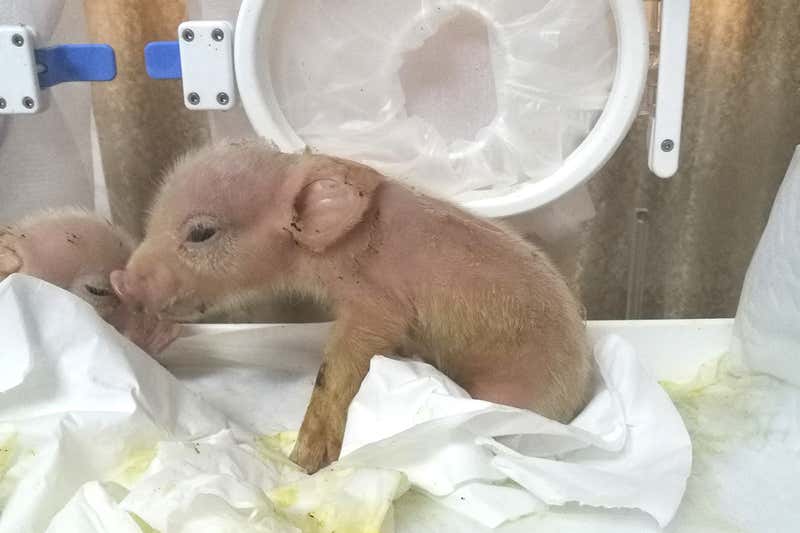In a lab in Beijing, two pigs with monkey cells were born — the very first time such a chimeric animal was bred. The monkey-pig piglets lived for only a week before they died of unknown causes. However, the ultimate goal of such research is to one-day grow human organs into other animals for transplants.

Chinese researchers at the State Key Laboratory of Stem Cell and Reproductive Biology in Beijing first genetically modified monkey cells in vitro in order for them to produce a fluorescent protein called GFP. This way, the researchers could track the monkey cells in the host animal. Isolated embryonic monkey stem cells were then implanted into pig embryos five days after fertilization.
A total of 4,000 embryos were implanted in female pigs, which gave birth to ten piglets, two of them being monkey-pig chimeras. The resulting animals didn’t look like some weird cross between the two mammals. The piglets looked and behaved like non-chimeras, however, their hearts liver, spleen, and lungs, as well as skin tissue, contained monkey cells — but in very small amounts, between one in 1,000 and one in 10,000.
A week later, all piglets, chimeras and non-chimeras alike, died of unknown causes. The Chinese authors suspect that their deaths are due to defects introduced by the in vitro fertilization process rather than chimerism. It’s well established that in vitro fertilization in pigs isn’t very efficient compared to humans and other mammals.
In the future, the researchers plan breeding chimeras with an even higher proportion of monkey cells. Ultimately, they would like to grow pigs with an entire heart or pair of lungs made of primate cells.
This isn’t some pointless mad science. Ultimately, human-animal chimeras could be bred to supply people who are in dire need of a transplant with fully biocompatible organs. In the United States alone, 22 people on the transplant waiting list die each day because there aren’t enough donors. And even if a patient is lucky enough to access a donor’s organs, life isn’t easy at all following the transplant.
Today, even the most well-matched organs can’t last long because our immune system continuously attacks them, seeing them as foreign bodies that need to be destroyed. That’s what immunosuppressant drugs are for, which transplant patients have to take all their lives. In the worst case, complications can force them to undergo a new transplant surgery or risk death.
The first successful efforts to breed chimeric animals were made in the 1960s when, one by one, scientists managed to give life in the lab to chimeric rats, sheep, rabbits or cattle. These weren’t cross-species chimeras, but rather organisms composed of cells from multiple genetically distinct individuals of the same species. In time, this kind of research proved to be invaluable to scientists’ ongoing stem cell research efforts.
Other cross-species chimeras include pig-human chimeras developed by a team in California in 2017. These chimeras contained about one human cell in every 100,000 pig cells — the embryos were only allowed to develop for a month due to ethical concerns that their brains could be part humans. In 2018, researchers at Stanford made sheep-human hybrids, which contained one human cell for every 10,000 sheep cells.
It remains to be seen whether human chimeras could ever work. The high death rate and low chimeric efficiency reported by studies thus far are no reason to be optimistic, but the prospect of rendering the donor list obsolete may be well worth the pursuit.


